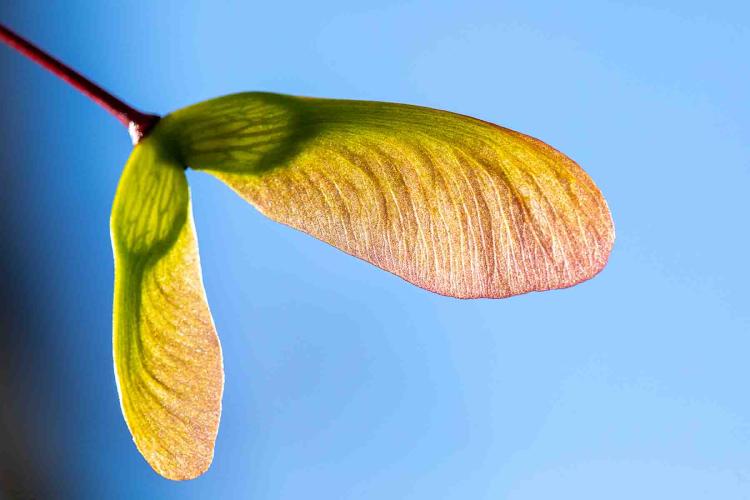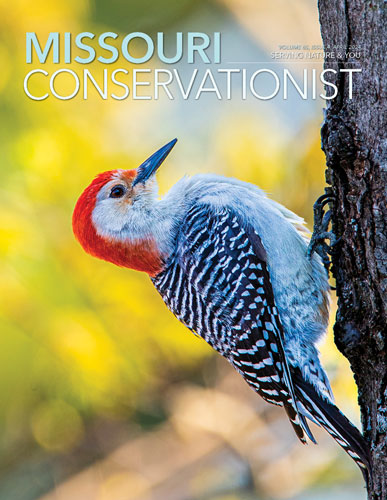Leave Wildlife Wild
Young animals may appear abandoned, but that’s seldom the case
As we head outdoors during this long-awaited spring season, you may encounter a variety of newborn wildlife. MDC asks that you “leave wildlife wild” by not interfering with newborn or young animals, as it can do more harm than good.
“Young animals are rarely orphaned,” said Missouri State Wildlife Veterinarian Sherri Russell. “If the young are left alone, the parent will usually return. Parents are normally out searching for food and cannot constantly attend to their offspring.”
Russell added that baby birds are a common newborn people want to help.
“If you see a chick on the ground hopping around and it has feathers, leave it alone and bring pets inside because it is a fledgling and the parents are nearby keeping an eye on it,” she said. “Fledglings can spend up to 10 days hopping on the ground while learning to fly. If you find one that is featherless, you can return it to the nesting area, if possible, as it probably fell out of the nest.”
Dogs catching baby rabbits and lawn mowers running over nests are other common issues.
“Rabbits seldom survive in captivity and can actually die of fright from being handled,” Russell said. “Even if the animal is injured, return it to the nest because the mother will most likely return.”
Despite what many think, wild mothers do not abandon their young because of a human scent, and most newborn animals do not survive in captivity.
“While people have good intentions, the care and rehabilitation of wild animals requires special training, knowledge, facilities — and permits,” she explained. “Without such care, wild animals will remain in poor health and could eventually die. And it is illegal to possess many wild animals without a valid state or federal permit.”
Russell also noted that wildlife can become dangerous as they mature and can also carry parasites and disease and can damage property.
“Native wildlife can carry mites, ticks, lice, fleas, flukes, roundworms, tapeworms, rabies, distemper, tuberculosis, respiratory diseases, and skin diseases,” Russell said. “Some of these can be transmitted to humans.”
Although tempting to take them into homes, the best help people can offer wild animals is to leave them alone.
For more information on Missouri’s many native wildlife species, visit the MDC online Field Guide at short.mdc.mo.gov/Z9d.
Celebrate Missouri Trees through Arbor Days in April
Celebrate the value of Missouri trees and forests during Arbor Days in April by planting native trees and practicing proper tree care.
Missouri Arbor Day is Friday, April 5. Missouri has been observing the state’s official Arbor Day on the first Friday in April since 1886 when the General Assembly declared that day be set aside for the appreciation and planting of trees. National Arbor Day is recognized on the last Friday of April, which is April 26.
Get information on backyard tree care — including types of trees for urban and other landscapes, selecting the right tree for the right place, planting tips, watering and pruning information, and more — at short.mdc.mo.gov/Z3J.
MDC’s George O. White State Forest Nursery near Licking offers residents a variety of low-cost native tree and shrub seedlings for reforestation, windbreaks, erosion control, and wildlife food and cover. Orders are accepted through April 15. For more information, visit short.mdc.mo.gov/ZNZ.
Communities around the state also hold local Arbor Day activities. For more information on Arbor Day and Missouri’s Tree City USA communities, visit the Arbor Day Foundation at arborday.org.
Missouri forests cover about one-third of the state and provide outdoor recreation, wildlife habitat, natural beauty, and watersheds for streams and rivers. Spending time in Missouri forests can provide natural health benefits, too. Exposure to nature contributes to your physical well-being, reducing your blood pressure and heart rate, relieving stress, and boosting your energy level. Get more information at short.mdc.mo.gov/47t.
2024 Fishing Prospects
Get a copy of MDC’s 2024 Fishing Prospects for a summary of fish population surveys done in the fall by the state’s fisheries biologists at MDC’s managed areas, and their predictions of the “best bets” locations for catching certain fish species.
The 2024 Fishing Prospects is available for free at MDC locations where publications are found, online at fishing.mdc.mo.gov, and through MDC’s free MO Fishing app available for download through Google Play for Android devices or the App Store for Apple devices.
Celebrate the Outdoors in April
Spring in Missouri is magical. The days get longer. The woods come alive with tiny buds on trees. Dainty wildflowers spring from the earth. Peepers are peeping, turkeys are scratching, coyotes are calling, owls are hooting, and birds are singing. This is the time of year to get outside and discover nature through hunting, fishing, biking, hiking, birding, camping, kayaking, canoeing, and other outdoor adventures.
Find things to do at short.mdc.mo.gov/45Z.
Find places to go at short.mdc.mo.gov/Z9o.
Corporal Tyler Brown
Camden County
Conservation Agent
If turkeys are gobbling, spring is here and so is spring turkey season. Youth season is April 6–7, with regular season following April 15–May 5. Take proper precautions to make this season safe. Know your target and what’s beyond it. Use hunter orange when carrying your harvest out of the woods and moving afield. Purchase your permit and Telecheck your bird. New this year — all-day hunting on private property. Gain permission if hunting on private property and know your boundaries. If your turkey hunt gets done early, try for the trifecta — look for some morel mushrooms and catch a limit of crappie. That’s a fine day in Missouri’s spring woods. For more information, consult the 2024 Spring Turkey Hunting Regulations and Information booklet at short.mdc.mo.gov/ZZf.
Wild Turkey and Sweet Corn Soup
Few things are tastier than Missouri wild turkey and sweet corn. This soup brings those two things together, a real Show-Me State delicacy.
Makes 6 cups of soup
Soup
- 2 ¼ cups frozen sweet corn
- 3 cups whole milk
- 2 tablespoons butter
- 1 large onion, chopped
- 1 large carrot, thinly sliced
- 1 celery stalk, thinly sliced
- 1 large garlic clove, minced
- 2 cups water
- 2 large fresh thyme sprigs
- 2 fresh rosemary sprigs
- 1 bay leaf
- 6 ounces cooked turkey (1 to 1 ½ cups)
- Freshly ground white pepper
- Two pinches of Spanish smoked paprika
Garnish
- 1 small sweet red pepper, diced
- 2 green onions, thinly sliced
- 2 tablespoons chopped fresh chives
Bring milk to boil in medium pot. Remove from heat, cover, and let steep while sautéing vegetables.
Melt butter in large saucepan over medium heat. Add onion and a pinch of salt, and sauté until translucent, about 5 minutes. Add corn kernels, carrot, celery, and garlic; cook until vegetables are soft, stirring frequently, about 15 minutes. Add water, thyme, and rosemary sprigs, bay leaf, and milk. Increase heat and bring to boil. Cover partially, reduce heat to low, and simmer 20 minutes.
Discard herb sprigs and bay leaf. Cool soup slightly. Puree half of soup in blender until smooth (taking care to press firmly on the lid with your hand during processing to prevent hot liquid from flying out of the top of the blender).
Pour contents of blender back into saucepan with remaining soup. Add turkey and stir. Reheat briefly. Season to taste with salt, white pepper, and paprika. Divide among bowls. Garnish with red pepper, green onions, and chives.




Maple Seed
Maples produce distinctive fruits consisting of basal seeds with elongated, flat, rather papery wings. The two seeds are initially fused but break apart when mature. The winged fruits often whirl down from the tree’s canopy like little helicopter blades. Globally, there are about 115 species of maples, but Missouri is home to just five species, including sugar, red, silver, box elder, and Siberian maples.
And More...
This Issue's Staff
Editor - Angie Daly Morfeld
Associate Editor - Larry Archer
Photography Editor - Cliff White
Staff Writer - Kristie Hilgedick
Staff Writer - Joe Jerek
Staff Writer – Dianne Van Dien
Designer - Shawn Carey
Designer - Marci Porter
Photographer - Noppadol Paothong
Photographer - David Stonner
Circulation – Marcia Hale






















